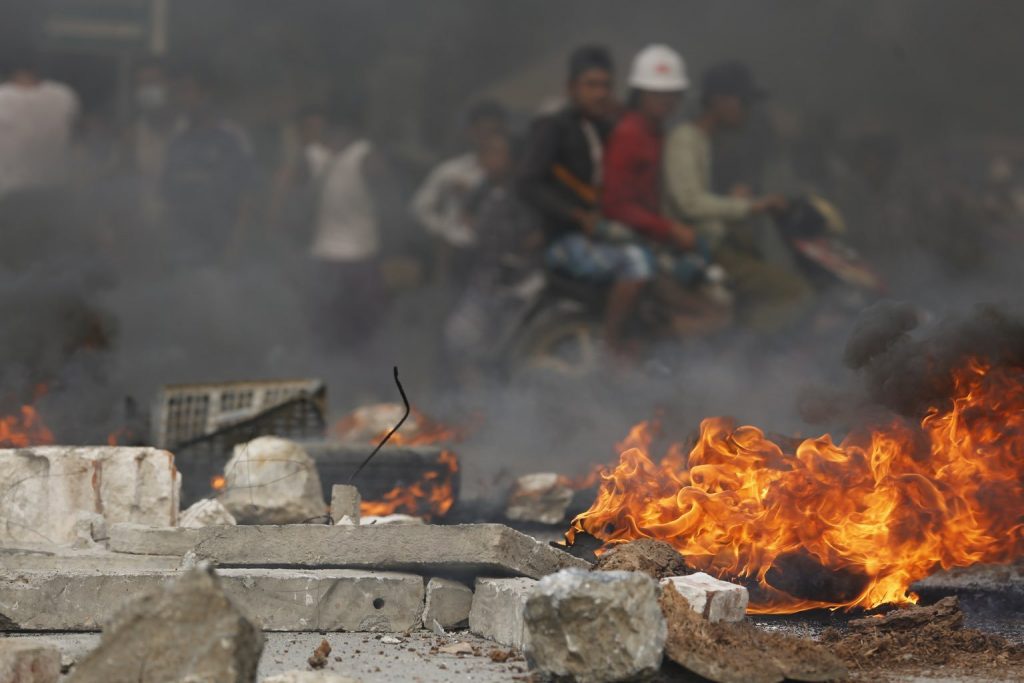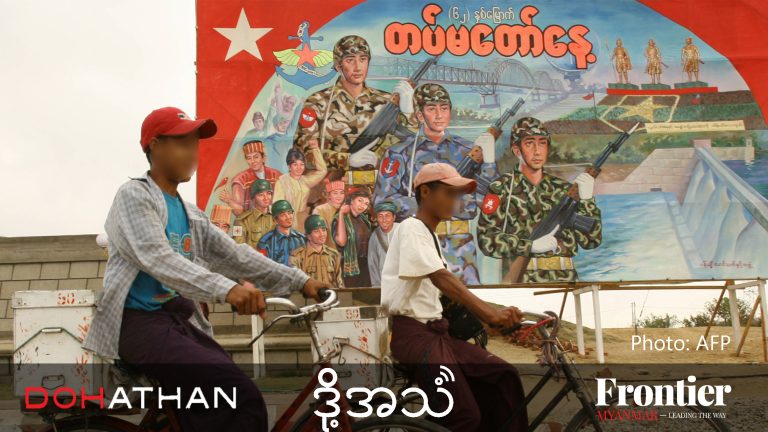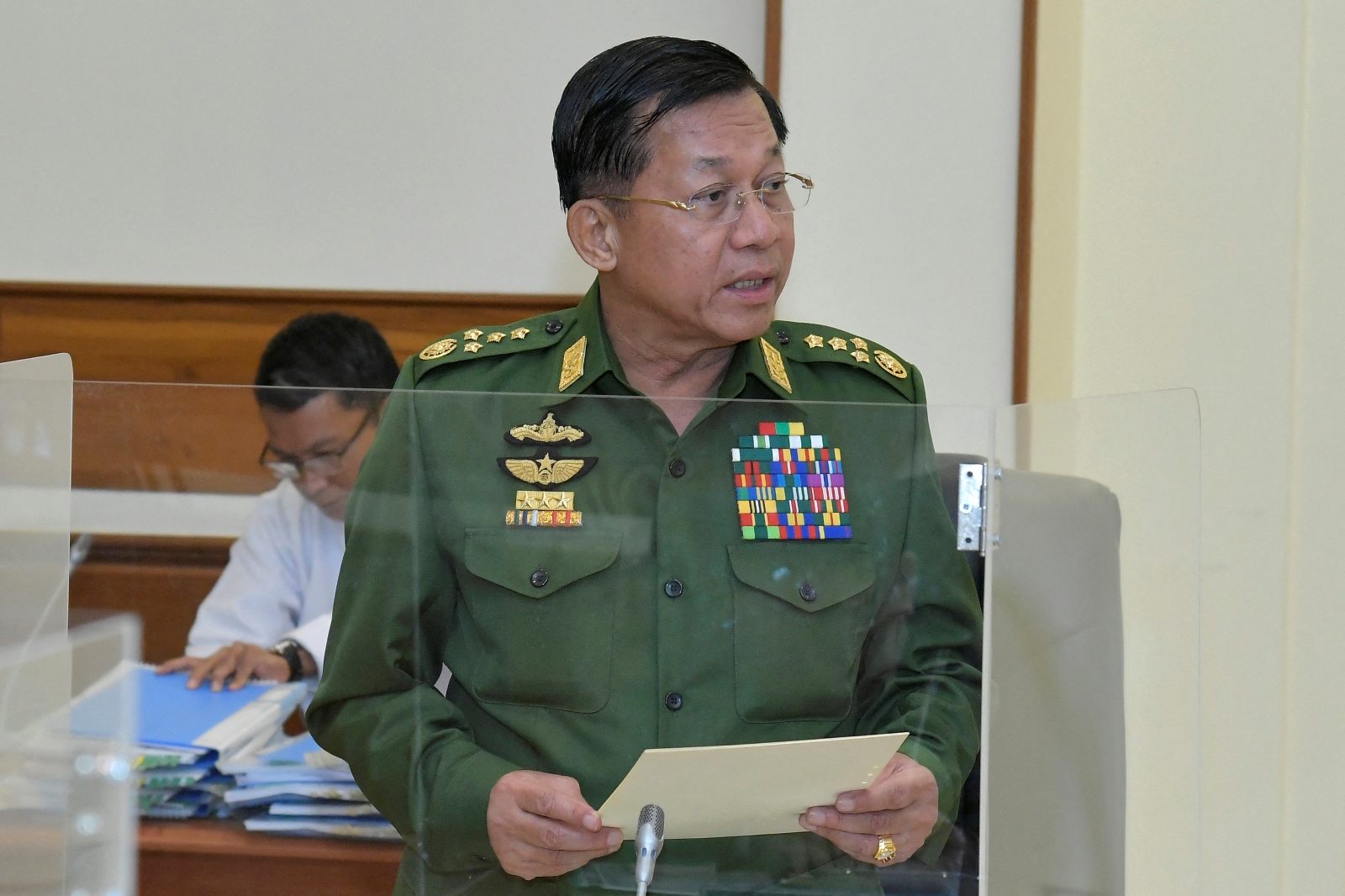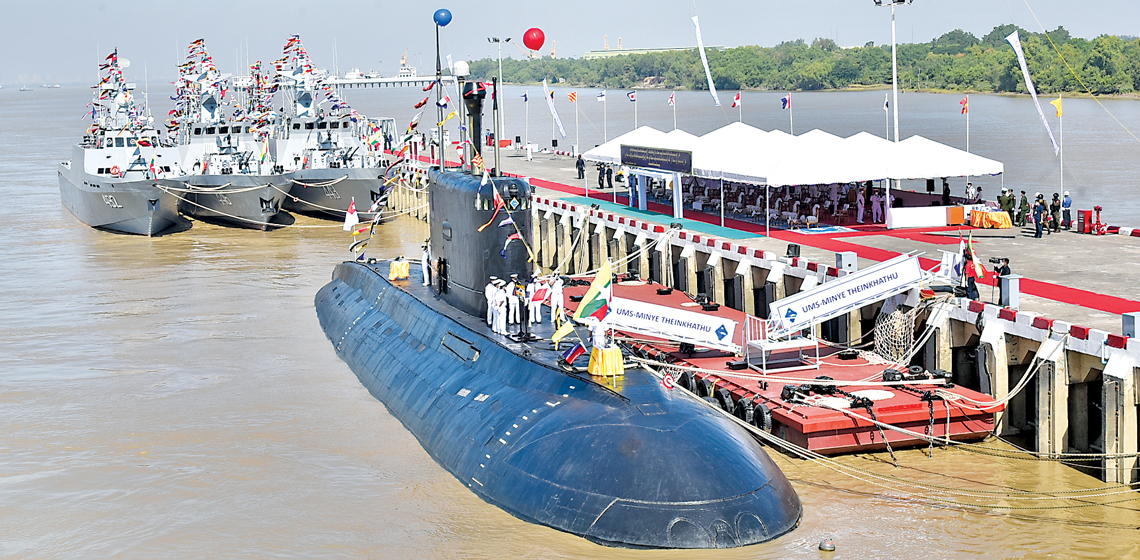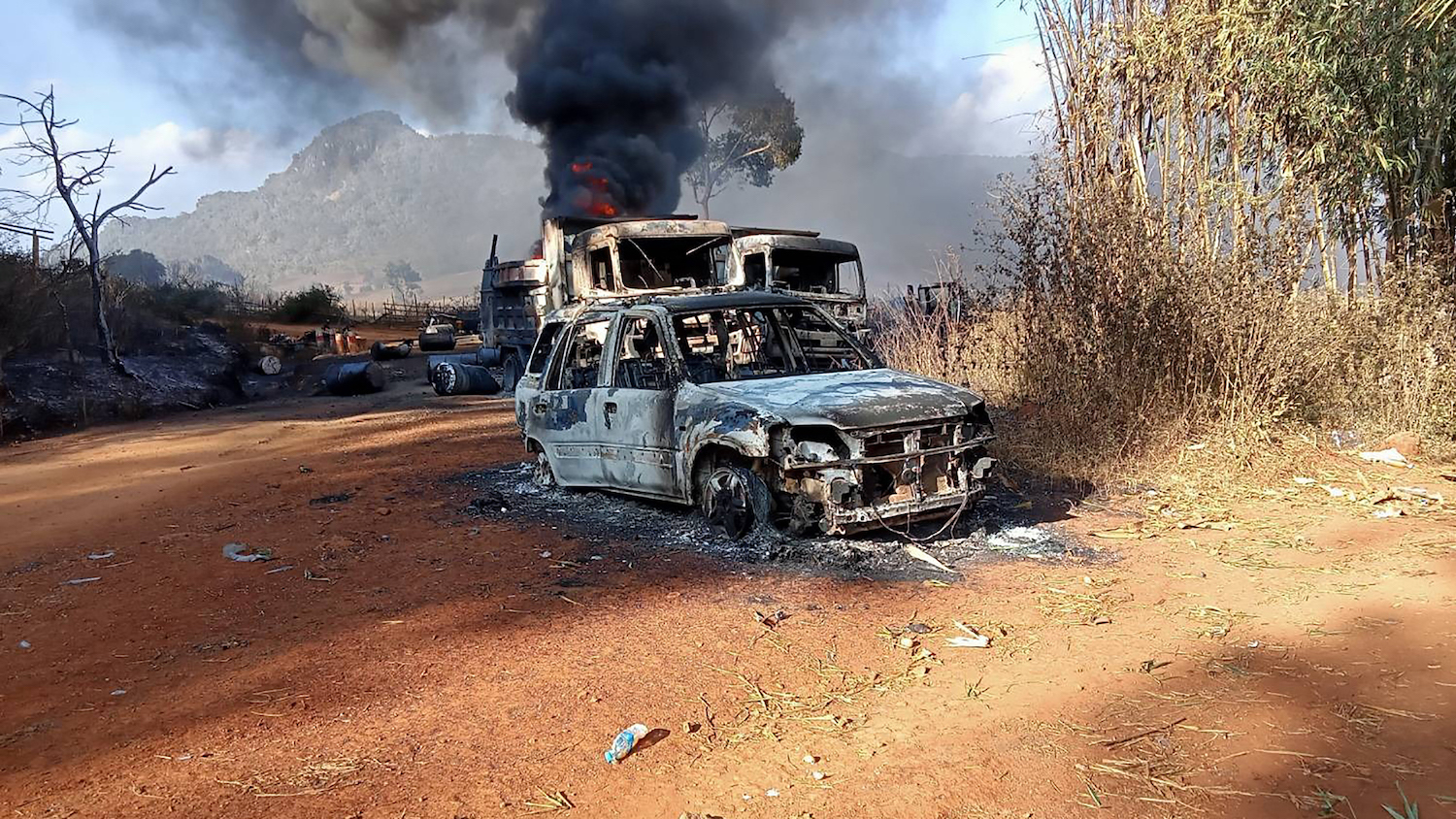A Frontier reporter who was shot on March 27 recounts the growing brutality of security forces in Myanmar’s second-largest city and their efforts to stop anyone trying to document their bloody crackdowns.
By FRONTIER
By the time I arrived at Sein Pan ward on March 27, it already looked like a battlefield. Smoke was rising from the junctions along 41st Street, and young protesters huddled behind barricades of sandbags and bamboo sheets were preparing to defend themselves from a frontal assault by security forces.
They were well aware of the dangers to come. Two weeks earlier, police and soldiers had brutally crushed a protest in this same ward of Mandalay’s central Maha Aung Myay Township, leaving several people dead and many more wounded. Hundreds were trapped in the narrow back streets of Sein Pan, but most managed to escape because daring volunteer rescue teams helped them evade the security forces, and guided them to safety.
March 27 is officially Armed Forces Day, but this year anti-military activists called it by its original name, “Revolution Day”, so named to commemorate the uprising against Japanese occupation at the end of World War Two in 1945. In Sein Pan, protesters were once again preparing to face off against security forces to mark the occasion.
They didn’t have to wait long before two police trucks entered 41th Street from the east and stopped about 200 metres from the first barricade. The police got out and immediately started shooting live rounds at the young protesters. I had been preparing to take photos, but immediately had to take cover. I suddenly felt like I was covering a war.
I positioned myself about 100 metres behind the barricades, from where I hoped to take photos. Behind me, three young boys were taking photos with their phone cameras. I began to warn them that the security forces were firing real bullets, and that they should move away, when a bullet went straight through the palm of my left hand, at the base of the ring finger.
My first thought was that if the bullet hadn’t hit my hand, it may have hit one of the boys instead. Then my hand felt simultaneously hot and numb, and I stopped thinking about the boys’ safety and started worrying about what damage might have been done.
Two of the boys took me to a nearby medical team, where I received first aid. I needed further treatment, but that was going to be difficult. They wanted to send me by motorcycle to an ambulance, but the security forces were blocking our exit on all sides and shooting. Fortunately, they managed to locate an ambulance near 41st Street and Strand Road. When I got in, they continued to treat my wound.
The ambulance had to drive carefully to avoid police and soldiers. At 2:30pm I finally reached a clinic for treatment, about three hours after I was shot.
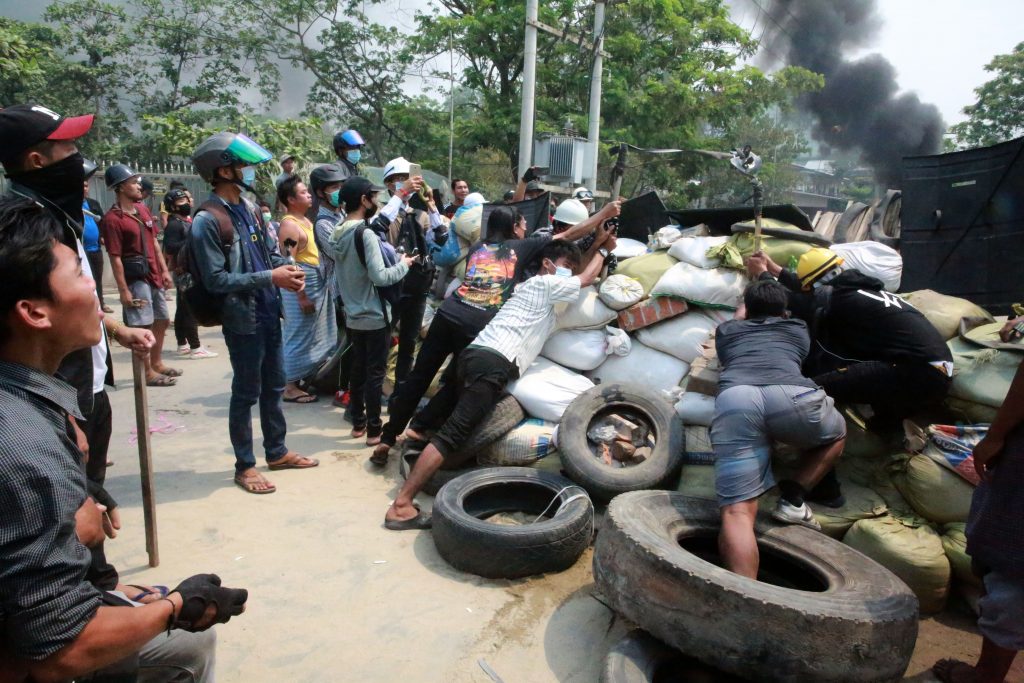
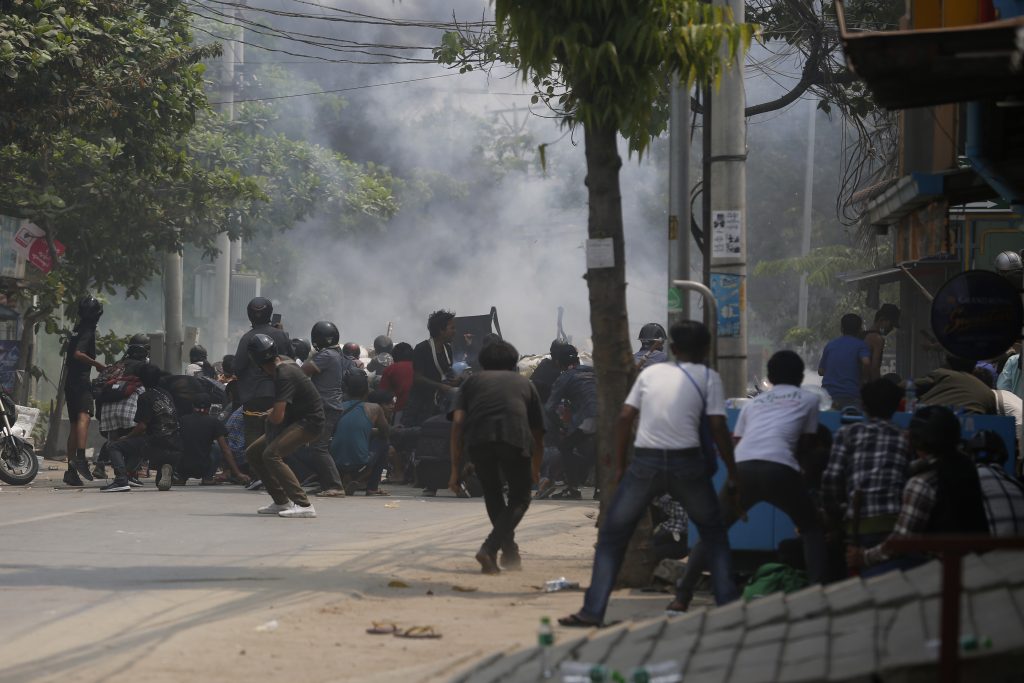
A week of bloodshed
Although it wasn’t yet noon, the shooting in Sein Pan was the third confrontation between security forces and activists I’d seen that morning. The Revolution Day demonstrations were among the largest in Mandalay since the February 1 coup, with numerous columns marching through the city.
At 6am, I’d watched striking medical workers shout revolutionary slogans as they drove around Aung Myay Thar Zan Township on motorcycles, the flag of their protest group flapping in the breeze. Security forces arrived almost immediately, so the protesters dispersed and regrouped to continue their protest elsewhere.
The Mya Taung group, which has protested every day since February 8 despite regular threats and intimidation from security forces, were also attacked while they were preparing to begin their march in Maha Aung Myay Township.
“We hadn’t even got moving when security forces converged on us from three sides and started to crack down. They beat us violently and 65 young protesters were arrested as the street was narrow,” said Ko Kyaw Gyi, who participates in the Mya Taung protest every day. “In the evening, we were able to rescue some of our protesters who were hiding in the streets. We’re not deterred though – we will continue fighting for democracy.”
Not far from Sein Pan, security forces were also arresting and shooting at residents and passers-by in the neighbourhood between 37th and 40th streets and 80th and 84th streets.
But the attacks on demonstrators on March 27 bookended a week of extreme violence in Mandalay that had seen at least 70 people killed.
In the lead up to Revolution Day, security forces had been focusing their repression on the densely populated wards of Aung Pin Lae, Aung Thaya and Mya Yee Nanda, all of which are located in Chan Mya Tharzi Township, in the south of the city. This area has been a dogged centre of resistance to the regime and was now feeling its brutal wrath.
The protests in these wards escalated from March 20, when demonstrators set up a series of large barricades of sandbags and bamboo poles and sheets to block the residential streets running north-south between Manaw Hari and Theik Pan roads. Also known as 110th Street, Manaw Hari is usually one of the city’s busiest thoroughfares but when I visited it was deserted, and the barriers gave it the appearance of a city under siege.
The junta responded by deploying large numbers of police and soldiers to the neighbourhood to crush the protests, and at least 25 people have been killed since March 20 in the area. Many more have been injured or detained.
In the face of this violence, protesters and residents have worked together to protect themselves as best they can. Residents have let demonstrators hide in their homes and informed them of the presence of soldiers and police on the streets. When I visited the area on March 22, residents warned protesters of the presence of snipers on roofs between 56th Street and Manaw Hari Street. A video was later shared on social media confirming that seven soldiers were located high up in buildings shooting at protesters.
At night, residents have remained alert, deploying guards to conduct patrols and erecting more barricades to replace those destroyed by security forces. Even so, police and soldiers have regularly entered the wards at night, terrorising residents by shooting and making arrests.
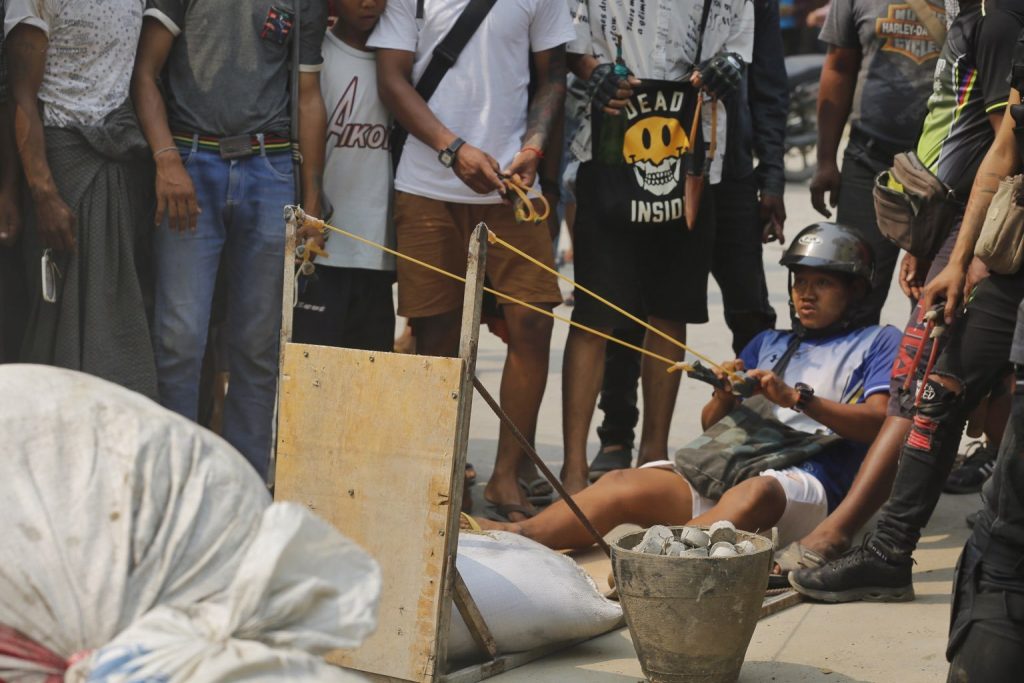
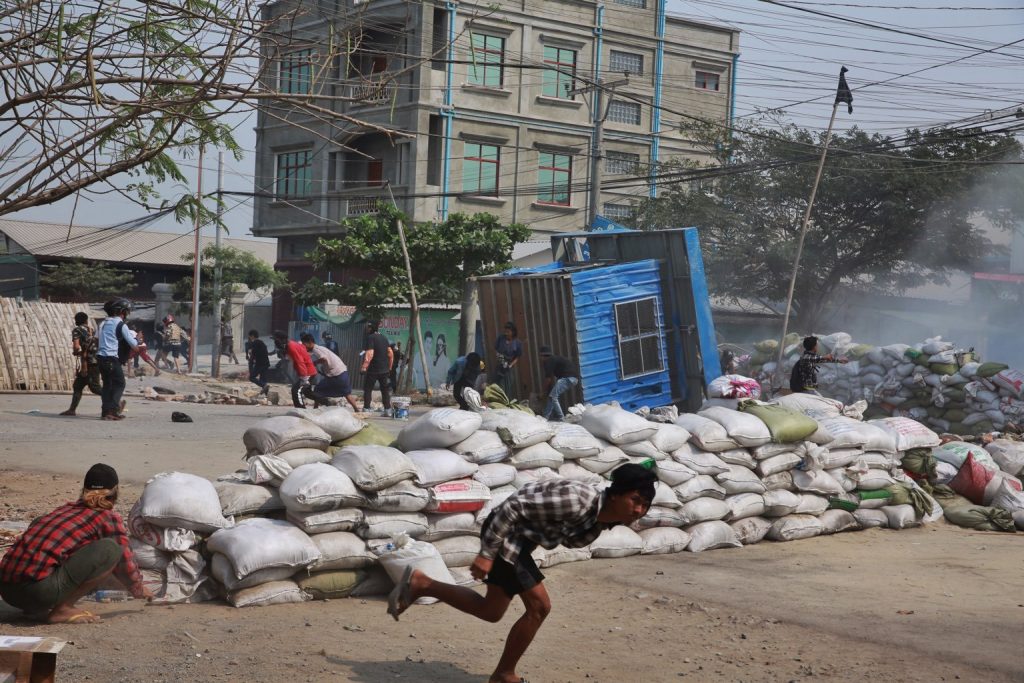
The crackdown
On March 22, the security forces staged their most vicious crackdown yet in Aung Pin Lae, Aung Thaya and Mya Yee Nandar wards. I ran for my life as soldiers and police shot at demonstrators like they were playing a video game.
The security forces had camped overnight south of the Mya Yee Nandar market, and started their rampage by destroying the barricades put up by protesters, which have included many young people, men and women, who identify as being from “Generation Z”. Without warning, the security forces then began shooting live rounds at protesters, who had set alight piles of car tyres at key junctions to try and block their advance.
I hid behind the barricades with the protesters, cautiously leaving cover to take photos whenever it seemed safe enough to do so. Before long, though, live rounds passed close to my head. When I turned around, I saw a man in his early 20s lying on the ground, blood pooling from a wound to his head. A group of people rushed towards the fallen protester and took him on a motorbike to a nearby ambulance, but he was soon pronounced dead. With a sense of shock, I realised that could easily have been me, and I retreated from the barricades as soon as it was safe to do so.
As the security forces advanced, the mostly young protesters dispersed. Against guns, all the protesters had to defend themselves with were fire extinguishers and smoke bombs. The troops continued to shoot as the protesters ran. It looked as though they were fighting soldiers from a battle-hardened ethnic army, but in reality they were just shooting at young, peaceful and mostly unarmed protesters who were running for their lives.
While I was running and trying to take photos, a man close to me, who was hiding behind a shed, was hit by a bullet. The man said his wound was not serious and urged me to help others, but his upper body was covered in blood and I had to call an ambulance. However, because of the shooting and barricades, there was no way for the ambulance to reach us, so I arranged for a motorbike to take the man to where an ambulance was waiting.
This was a common problem, one that I would later have myself. But it’s not just about access, it’s also an issue of safety. The security forces have dispensed with any discrimination when they open fire – they will shoot at a journalist, medic or bystander just as soon as a young protester with a home-made shield. Yet volunteer health workers get as close to the front lines as they possibly can and have saved innumerable lives. I have seen them risk death and injury so many times to help save others – they are the unsung heroes of this crisis, and I will be forever grateful to them.
Despite the carnage that day, the violence in the three wards in Chan Mya Tharzi Township didn’t end on March 22. The next morning, the military began clearing demonstrators’ barricades with bulldozers. They then shot at the remaining protesters; I saw one man get hit in the head, and he died while on the way to a nearby clinic. The soldiers and police split into multiple groups and moved through the wards looking for protesters. They looked like lawless gangs, forcing their way into homes and beating and arresting anyone they suspected of being a protester.
But it’s not only the security forces that residents and protesters need to avoid. One of the differences from Yangon is that, in Mandalay, there are many groups of men in civilian clothing who aid police and soldiers. Many assume that they are Swan Arr Shin, a paramilitary force of hired thugs that the Tatmadaw in previous times would unleash on those challenging its authority.
These groups of men can be seen either going by foot or on motorbikes, and they pretend to be ordinary residents. But then they attack protesters with home-made weapons, usually before police and soldiers arrive, though sometimes they accompany the security forces. If they see people who they think are protesters, they detain them and call in the security forces to take them away.
On March 23 I got a closer look at one of these groups. While I was taking photos, I saw about 10 men walking on the street in Aung Pin Lae ward. Assuming they were residents, I took a photo of them, but quickly realised I’d made a mistake when they pulled out slingshots and began firing at me. As they approached, I hurriedly put my camera in my backpack and ran. If they had the chance, I’m sure they would have detained me.
When I returned home that night, I was shocked to learn that security forces had just shot dead a seven-year-old girl, Ma Khin Myo Chit, in Chan Mya Tharzi Township.
Khin Myo Chit was killed while sitting on her father’s lap inside her home.
Worried that the military would seize Khin Myo Chit’s body, her family, who are Muslim, conducted the funeral quickly, and reportedly faced difficulties burying her according to Islamic tradition.
On March 24, quietness descended on Mandalay, and the rest of the country, as demonstrators nationwide took part in a silent protest. It would be only a temporary reprieve. March 27 would be the deadliest day the country has seen so far since the coup; an estimated 112 people were killed nationwide on Revolution Day. At least 48 of these were in Mandalay Region, according to monitoring groups – the majority in the city of Mandalay.
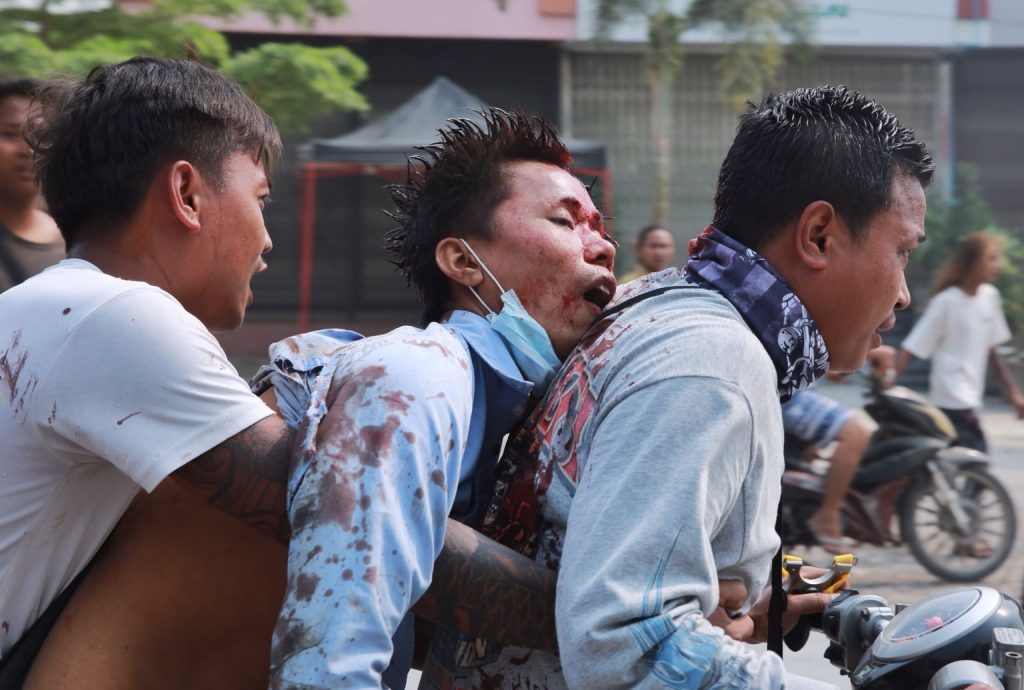
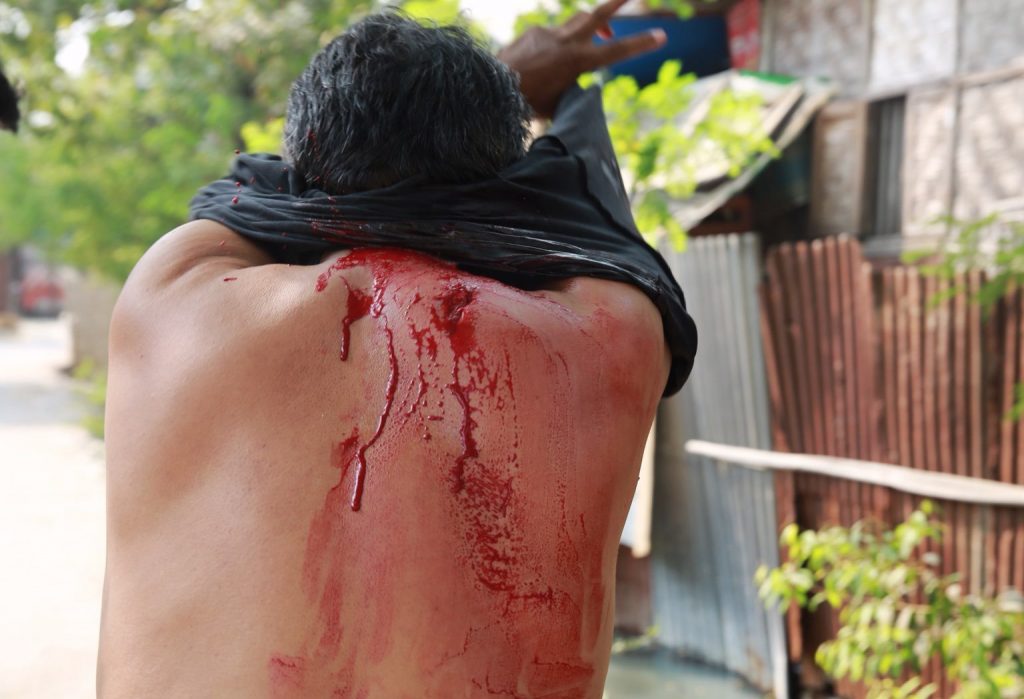
A deadly job
For journalists, covering the protests has now become both difficult and dangerous.
This is because of the attitude of the security forces. They have been deploying lethal force against peaceful protesters, which by itself is a reprehensible act. But when they do so, they have also not been trying to differentiate between the press and the protesters.
The 2014 News Media Law allows a journalist to cover armed conflicts, riots and demonstrations “in compliance with regulations specified by relevant and responsible organisations”. The law says reporters are exempt from “being detained by certain security related authorities, or his/her equipment being confiscated or destroyed”.
In Mandalay, after the coup, we had initially been able to get close to the police and soldiers, and we even took videos and photos from their side of the protests. But after footage of the security forces killing protesters at the city’s Yadanarpon shipyard on February 20 was shared widely on social media, they have tried to cover up their actions. Anyone trying to document the crackdowns on protesters has become a target – journalists included. I can barely count the number of times I’ve had to run to avoid arrest.
To date, at least 56 journalists have been detained since the coup and five media organisations have been banned. Although some detained journalists have been released, others are facing criminal incitement charges that carry a prison term of up to three years.
Other journalists have, like me, been injured while trying to do their job.
Shortly after arriving at the clinic on March 27, I had an x-ray to assess the damage. The image (see below) showed that the bones in my ring finger, middle finger and index finger had been crushed by the impact of the bullet, and would have to be reconstructed and pinned. I would also need a transplant to put flesh back onto the palm of my hand.
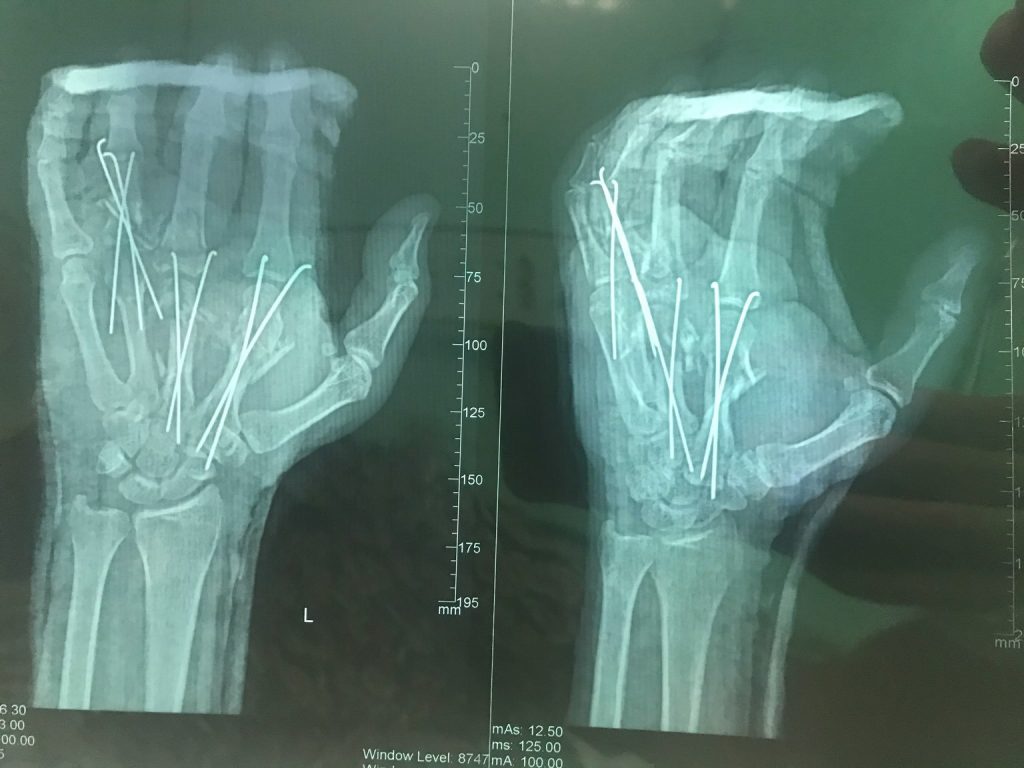
I’ve already had to undergo two operations, and will need further surgery. I’m not sure what the long-term damage will be. My biggest frustration though is that the injury has forced me to stop covering the protests.
Mandalay was the first city to erupt in protest after the coup; by the time I was shot, I had been covering the demonstrations for more than 50 days straight. To lie in a hospital bed knowing that the protests were continuing and I was unable to document them was almost as painful as the injury itself.
But I haven’t given up. I’m typing this now with my good hand, which I also use to make phone calls to get information. As soon as I can, I’ll be back out there. And I know that, regardless of how the military regime targets journalists, my colleagues will be just as determined to continue doing their job, too.


